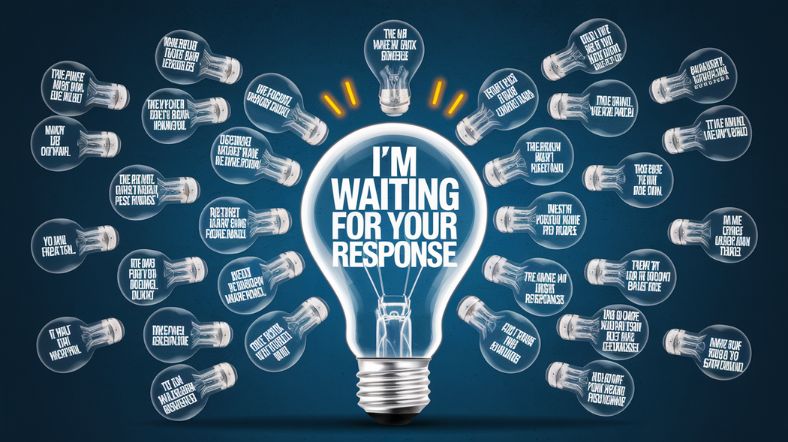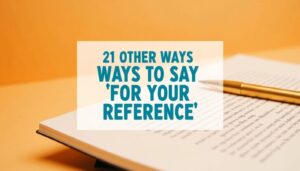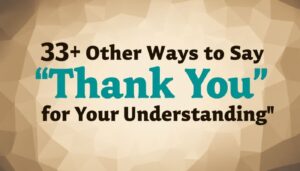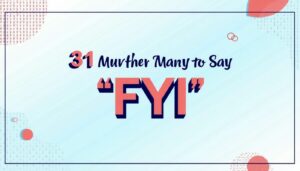In both personal and professional communication, waiting for a response can feel like a delicate moment.
Whether you’re sending an email, engaging in a conversation, or waiting for feedback, how you express your patience and anticipation can make a big difference in the tone and direction of the interaction.
The phrase “I’m waiting for your response” is often used, but there are countless other ways to express this message that can sound more engaging, polite, and varied.
In this article, we’ll explore alternative phrases, each suited for different situations, helping you communicate effectively and with confidence.
I Will Be Waiting for Your Response (Formal)
This phrase maintains a respectful tone, suitable for professional settings. It conveys patience but also an expectation for timely feedback.
Example: “Thank you for reviewing my proposal. I will be waiting for your response to move forward with the next steps.”
When to Use: Ideal for emails, formal correspondence, or business meetings.
How Can I Politely Tell Someone That I’m Waiting for Their Response?
Sometimes, direct phrasing can feel a bit blunt. In these situations, a softer approach can work wonders.
Example: “I look forward to your reply and will be happy to address any further questions you might have.”
When to Use: Casual conversations or professional environments where you want to convey patience and openness.
I Will Be Waiting for Your Response Meaning
This phrase signifies anticipation and indicates you are ready for the other person’s feedback.
Example: “I appreciate your time and will be waiting for your response regarding the matter we discussed.”
When to Use: Good for formal situations when you’re expecting a response before proceeding with other tasks.
How to Say I’m Waiting for You?
This expression can be more personal or informal, depending on the relationship.
Example: “I’ll be here waiting for you to get back to me whenever you’re ready.”
When to Use: Casual or intimate settings, such as among friends or loved ones.
Best Reply for Waiting
This phrase emphasizes the expectation of a thoughtful reply. It is professional but allows room for the other person’s perspective.
Example: “I’m eagerly waiting for your response so we can finalize the details.”
When to Use: In a business context or when awaiting a response with key decisions attached.
We Are Waiting for Your Reply to Proceed Further
This is a direct and formal phrase used to express that you cannot move forward without the person’s response.
Example: “We are waiting for your reply to proceed further with the agreement.”
When to Use: Business emails or situations where timing is important for a project or decision.
I Am Waiting for Your Reply (SMS)
In a more informal context like text messages, this phrase is commonly used when you’re looking for a quick response.
Example: “Hey, I’m waiting for your reply to confirm our meeting time.”
When to Use: Texts or messages with friends, family, or close colleagues.
Best Reply for Waiting to a Guy
This phrase conveys a more personal, slightly informal tone when awaiting a response from a man.
Example: “I’ll be waiting for your thoughts on our weekend plans.”
When to Use: Casual interactions with a friend, date, or colleague.
Waiting for Your Reply
A simple and straightforward way to express that you’re waiting for a response, suitable for both formal and casual contexts.
Example: “Waiting for your reply before I can confirm the details.”
When to Use: Ideal for emails, follow-up messages, and even casual texts.
Looking Forward to Your Reply
This phrase sounds optimistic and polite, conveying a sense of anticipation.
Example: “Looking forward to your reply about the project proposal.”
When to Use: Formal business emails or any situation where you want to express eagerness without pressure.
We Are Waiting for Your Response
This phrase is commonly used in professional or customer service contexts when a group is awaiting feedback.
Example: “We are waiting for your response to proceed with the next phase of the project.”
When to Use: Used in collaborative environments, corporate emails, or group-based discussions.
Awaiting Your Response
This is a concise, formal way of expressing that you are waiting for someone’s reply.
Example: “I’m awaiting your response to finalize the arrangements.”
When to Use: Professional or formal emails, letters, or messages.
Eagerly Awaiting Your Thoughts
This phrase conveys a high level of anticipation, showing you’re excited for the other person’s input.
Example: “Eagerly awaiting your thoughts on the report.”
When to Use: Ideal for professional situations or when seeking feedback on important matters.
Anticipating Your Feedback
This phrase works well when you expect constructive criticism or insights.
Example: “Anticipating your feedback so we can proceed accordingly.”
When to Use: Used when requesting reviews, feedback, or suggestions.
Hoping to Hear From You
A softer, more personable expression of waiting, showing a positive outlook on receiving the reply.
Example: “Hoping to hear from you soon about the upcoming project.”
When to Use: Casual conversations or when reaching out to someone in a friendly tone.
Awaiting Your Input
This phrase focuses on the expectation of receiving valuable information.
Example: “I’m awaiting your input on the final draft.”
When to Use: Appropriate in work contexts where collaboration or contributions are needed.
Excited for Your Response
Conveys an upbeat tone, making the waiting feel more enthusiastic and positive.
Example: “Excited for your response—let me know what you think!”
When to Use: Casual, enthusiastic conversations where you want to create excitement about the outcome.
Can’t Wait for Your Thoughts
A casual and energetic way to express your eagerness for a reply.
Example: “Can’t wait for your thoughts on the idea I proposed.”
When to Use: Friendly or informal interactions, especially when discussing creative ideas.
Looking for Your Insights
This phrase is more focused on seeking expert advice or valuable perspectives.
Example: “Looking for your insights before we make a decision.”
When to Use: Professional settings where you value the person’s knowledge or experience.
Ready for Your Update
This phrase is often used when you are waiting for progress or news.
Example: “Ready for your update on the status of the project.”
When to Use: Used in business or collaborative contexts when awaiting a report or an update.
Anxiously Awaiting Your Reply
A bit more dramatic and emotional, this phrase indicates that you are eagerly and slightly impatiently waiting.
Example: “Anxiously awaiting your reply I’m really looking forward to hearing from you!”
When to Use: Suitable for personal communication, especially when awaiting important news or decisions.
Conclusion
Knowing how to express “I’m Waiting for Your Response” can elevate the quality of your communication. Whether in formal or casual contexts, using a variety of phrases adds a touch of professionalism and warmth. Phrases like “Looking Forward to Your Reply” or “Excited for Your Response” can signal eagerness without sounding overly demanding.
For professional emails, phrases like “We Are Waiting for Your Response” or “Awaiting Your Input” can be particularly effective. They maintain a respectful tone while encouraging the recipient to respond promptly. In more casual conversations, expressing your anticipation with phrases like “Can’t Wait for Your Thoughts” or “Hoping to Hear From You” creates a friendly, approachable atmosphere.
In the end, using alternative ways to say “I’m Waiting for Your Response” not only helps maintain positive communication but also adds nuance to how you interact. Tailoring these phrases based on your relationship with the recipient will ensure that your message is both polite and engaging. Whether it’s “Eagerly Awaiting Your Thoughts” or simply “Ready for Your Update,” choosing the right phrase can enhance both personal and professional interactions.

Mark Tony is a grammar expert with 5 years of experience, specializing in teaching English grammar, enhancing writing, reading, and speaking skills for diverse learners.









